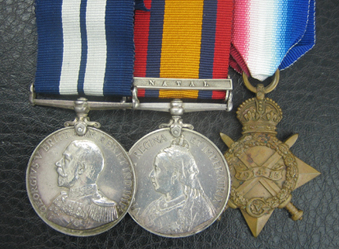
DISTINGUISHED SERVICE MEDAL, G.V.R. ‘191473 H. C. WRIGHT, LG. SEAN. H.M.S. “D7” ATLANTIC OCEAN 12TH SEPT. 1917’ QUEEN'S SOUTH AFRICA 1899-1902, 1 CLASP, NATAL (H. C. WRIGHT, A.B., H.M.S. DORIS’, 1914-15 STAR ‘191473 H. C. WRIGHT, L.S. R.N.’
D.S.M. London Gazette 17 November 1917: ‘For services in action with enemy submarines.’
The recommendation states: ‘Sinking of German submarine U45 12 September 1917. Since joining the flotilla on 14 April Submarine D7 has done 99 days on patrol and 54 days in harbour, which I believe to be a record for any overseas patrol, and which has only been possible through the sustained and united hard work of the whole of the crew, and especially the engine room staff.’
Herbert Charles Wright was born on 10 July 1881, and joined the Navy in July 1899. Serving aboard H.M.S. Doris during the Boer War, the Naval Brigade from Doris were involved in the Battle of Graspan on November 25th 1899 and subsequently assisted in the capture of Johannesburg and Pretoria. Wright joined the submarine branch in November 1912 and served aboard H.M. Submarine D7 from that date until February 1919. He served aboard E33 towards the end of that year and was Shore Pensioned in July 1921.
A successful and relatively reliable class of submarine, the D class worked very hard during WWI, patrolling the North Sea and the Heligoland Bight, and protecting the cross channel troopships.
https://en.wikipedia.org/wiki/HMS_D7
With a crew of 25 Officers and men, in May 1915, while patrolling in the German Bight, H.M.S. D7 was attacked from the air, but all 3 bombs dropped on her missed and she escaped without damage or casualties.
On 15 May 1915, she departed Great Yarmouth for a patrol in the North Sea, but sprang a leak and returned home for repairs. After repairs she continued regular patrols in the German Bight, accompanied by H.M.S. D8.
“It was not until September 1917 that a patrol submarine north of Ireland achieved a sinking. U-45 (Sittenfield) had sailed with U-88 and U-54 on the 5th; a week later she was on the surface west of the Shetlands when D-7 sighted her and dived to attack. Twenty minutes later a stern torpedo, fired at 800 yards, struck the U-boat just before the conning tower. One of the two survivors picked up by the British submarine was the radio operator, who had been about to send a message to Wilhelmshaven. He did not have time to do so, and the German command had no idea as to where U-45 was sunk.”
U-45, commanded by Kapitänleutnant Erich Sittenfeld, a successful U-boat, having sunk 27 allied ships and damaged one. Of the c45 man crew, 2 survived.
https://uboat.net/wwi/boats/?boat=45
The commanding officer of D7, Lieutenant O. E. Hallifax, was awarded the D.S.O. for this action, as well as one D.S.C. and two further D.S.M.s to other members of the crew (including Leading Seaman Wright).
On 10 February 1918, D7 was depth-charged by H.M.S. Pelican but survived the attack:
“There are some first hand reports on our own depth charges:— Submarine "D7," February 10th, 1918 (Lieut. Tweedy), suddenly sighted H.M.S. Pelican through her periscope. She increased to full speed and went down deeper, altering course from north to west. At ‘3.48 P.M.: First explosion occurred, load and violent but no damage or inconvenience. Very shortly afterwards a second explosion. This was considerably more violent, shattering several lights and flooding the afterperiscope. Heavy shock throughout the boat but no serious damage. Order was given to ‘blow externals’. Whilst rising, a third explosion occurred of about the same intensity as the first. On breaking surface made recognition signals’..”
In May 1918, D7 collided with a U-boat while passing underneath it. Her periscopes were damaged but the boat was otherwise unscathed. Obsolete at the end of the Great War, H.M.S. D7 was sold for scrap on 19th December 1921.
Condition GVF/VF, light contact wear to D.S.M./Star, Q.S.A. with minor EK’s. Sold with copy service papers and other research. A fine and scarce award for a sub on sub sinking. Ex DNW 2007 (£1600 hammer).